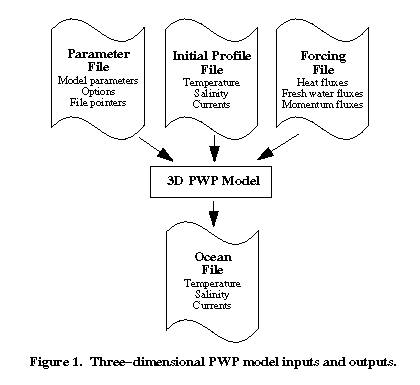
Scientists in the Upper Ocean Processes (UOP) group at the Woods Hole Oceanographic Institution (WHOI) have often relied upon a one-dimensional model (Price et al., 1986) to describe the response of the oceanic mixed layer to local atmospheric forcing. This model, dubbed the PWP model after its developers, predicts the vertical distribution of temperature, salinity and velocity at a single location from an initial profile of these properties and observations of heat, fresh water and momentum fluxes at the sea surface. Meteorological and oceanographic data collected from moored buoys are used to estimate these fluxes, and the PWP predictions can be compared to in-situ observations of temperature, salinity and velocity. When the model and the observations diverge, oceanic advective processes (e.g., the passage of an eddy) or non-local atmospheric forcing (e.g., horizontal variability in the wind field resulting in Ekman pumping) are assumed to be influencing the mixed layer. In situations where these non-local effects are important, a one-dimensional model is inadequate.
The passage of a hurricane over the ocean is an example of non-local atmospheric forcing. The horizontal heat, fresh water and momentum fluxes vary significantly within a hurricane, and this variability drives currents which cannot be captured by a one-dimensional model. To study the response of the upper ocean to the passage of a hurricane, WHOI's Jim Price and others developed a three-dimensional mixed layer model which incorporates a simplified one-dimensional PWP model into a hydrostatic, primitive equation model (Price et al., 1994). All vertical mixing in this new model is exactly the same as in the one-dimensional PWP model, but horizontal and vertical advection and pressure-induced horizontal accelerations are incorporated. The ocean is represented very simplistically, with no lateral boundaries, a rigid lid, and no bottom, and at initialization, it is horizontally homogenous.
The UOP group has adapted Price's ocean/hurricane model to investigate the upper ocean response to more generic horizontal forcing fields. To accomplish this, the original model code was completely re-written with several enhancements. The full one-dimensional PWP model of Price et al. (1986) was implemented, since the simplified version originally used in the three-dimensional model neglected fresh water fluxes. A beta-plane approximation was also implemented to capture dynamics influenced by the variation of the Coriolis parameter with latitude. The estimation of time derivatives or tendencies was changed to the Runge-Kutta method, a computationally expensive but more accurate technique than the leapfrog, trapezoidal method used by Price. Finally, several operational changes were implemented to make the model much easier to run by a non-programmer. Primary among these changes was the development of a modifiable parameter file with which the user can control various aspects of the model run.

The input and output files for the model are shown in Figure 1. The parameter file is a simple text file in which the user can specify the filenames of the initial profile, forcing file and ocean file, the model parameters (e.g., mixing criteria or beta/f plane) and output options. The initial profile file is also a text file which contains the starting vertical profile of temperature, salinity and zonal and meridional currents. The entire model domain is initialized with this starting profile so that the ocean is horizontally homogenous. The forcing file is an EPIC-compliant NetCDF file containing the two-dimensional surface heat, fresh water and momentum fluxes for each time step. Since the generation of the forcing fields is separate from the execution of the model, programming changes to the actual model code are unnecessary. This approach guarantees that the model code remains fixed and only the forcing, initial profile or the model parameters change from one model run to the next. The model outputs the temperature, salinity and zonal and meridional currents at each grid cell in the EPIC compliant, NetCDF ocean file. Output options include storing the model results at one location only (a profile), storing the surface results or storing the entire three-dimensional domain. Visualization of the model results is facilitated by a custom viewer developed by the UOP group. This software allows a user to view the time evolution of temperature, salinity, currents or several derived variables, such as divergence or shear, on 'slices' of the three-dimensional domain in a movie format.
This model is currently being used to investigate the ocean response to enhanced fluxes due to squall events over the warm pool of the western tropical Pacific. Forcing fields from a warm pool squall modeled by the National Center for Atmospheric Research (NCAR) serve as input to the three-dimensional model. The model may be able to explain the fate of fresh water patches deposited by these squalls as well as characterize the importance of the squall events to the maintenance or destruction of the warm pool.
Mark Baumgartner is a Research Associate in the Physical Oceanography Department and a member of the UOP group at the Woods Hole Oceanographic Institution.
 Return to UOP Homepage
Return to UOP Homepage